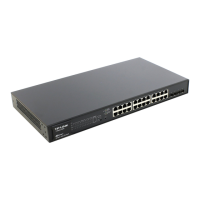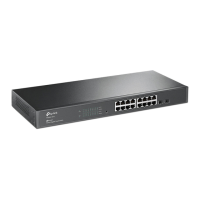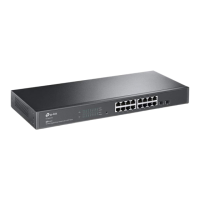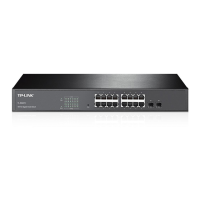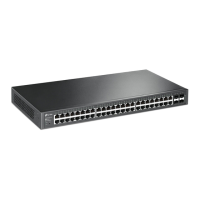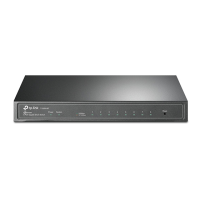Do you have a question about the TP-Link T1600G-28PS and is the answer not in the manual?
Details on accessing the switch's web interface, including login procedures and browser compatibility.
Explains access methods via Console, Telnet, and SSH, detailing connection requirements and applications.
Guides on creating admin accounts and other user types, including enabling passwords for administrative privileges.
Details on managing configuration files: boot file, firmware upgrade, reboot, reset, and backup.
Covers configuring Access Control, HTTP, HTTPS, SSH features, and enabling Telnet functionality.
Explains how to configure port mirroring to forward packet copies to a monitoring port for analysis.
Guides on limiting MAC addresses per port to prevent MAC address table exhaustion by attack packets.
Details on configuring global load-balancing algorithm and setting up Static LAG or LACP.
Covers adding static MAC entries, changing aging time, adding filtering entries, and viewing table entries via GUI and CLI.
Guides on configuring PVID of ports and creating VLANs, including adding ports to VLANs via GUI and CLI.
Details on configuring 802.1Q VLAN, binding MAC addresses to VLANs, and enabling MAC VLAN for ports via GUI and CLI.
Guides on configuring 802.1Q VLAN, creating protocol templates, and configuring Protocol VLAN via GUI and CLI.
Details on configuring STP/RSTP parameters globally and on ports, and verifying configurations via GUI and CLI.
Guides on configuring MSTP region, global parameters, and port parameters in CIST, plus verification.
Covers configuring Loop Protect, Root Protect, BPDU Protect, BPDU Filter, and TC Protect functions for enhanced network stability.
Guides on configuring IGMP Snooping globally, on ports, in VLANs, and setting up querier, profiles, and static members via GUI and CLI.
Details on configuring MLD Snooping globally, on ports, in VLANs, setting up querier, profiles, and static members via GUI and CLI.
Guides on creating Layer 3 interfaces (VLAN, Loopback, Routed Port, Port-channel) and configuring IPv4/IPv6 parameters via GUI and CLI.
Details on adding IPv4 static routes via GUI and CLI, specifying destination, mask, next hop, and distance.
Guides on enabling IPv6 routing and creating IPv6 static routes via GUI and CLI, including address formats.
Guides on configuring a Layer 3 interface as a DHCP client to dynamically obtain IP addresses via GUI and CLI.
Details on enabling DHCP Relay, configuring Option 82, and specifying DHCP servers for interfaces or VLANs via GUI and CLI.
Guides on viewing dynamic and static ARP entries, adding/deleting static entries, and configuring ARP function via GUI and CLI.
Details on configuring priority modes (802.1P, DSCP, Port) and schedule modes (SP, WRR, SP+WRR, Equ) via GUI and CLI.
Guides on creating VLAN, configuring OUI addresses, Voice VLAN globally, and Voice VLAN mode on ports via GUI and CLI.
Details on configuring PoE parameters manually or using profiles, covering system power limit and port-specific settings via GUI and CLI.
Guides on creating ACLs (MAC, Standard-IP, Extended-IP, IPv6) and configuring policies and bindings via GUI and CLI.
Details on manual and dynamic IP-MAC binding, including ARP Scanning and DHCP Snooping, via GUI and CLI.
Details on configuring RADIUS server, 802.1X globally, and on ports, including AAA setup via GUI and CLI.
Guides on configuring AAA globally, adding servers/groups, method lists, application lists, and login/enable passwords via GUI and CLI.
Guides on enabling and configuring LLDP globally and on ports, including parameters and TLVs, via GUI and CLI.
Guides on configuring local and remote logs, backing up log files, and viewing log tables via GUI and CLI.
Guides on completing SNMP configuration by choosing version, enabling SNMP, creating views, groups, and users via GUI and CLI.
Guides on configuring RMON statistics, history, event, and alarm entries via GUI and CLI.
Details on accessing the switch's web interface, including login procedures and browser compatibility.
Explains access methods via Console, Telnet, and SSH, detailing connection requirements and applications.
Guides on creating admin accounts and other user types, including enabling passwords for administrative privileges.
Details on managing configuration files: boot file, firmware upgrade, reboot, reset, and backup.
Covers configuring Access Control, HTTP, HTTPS, SSH features, and enabling Telnet functionality.
Explains how to configure port mirroring to forward packet copies to a monitoring port for analysis.
Guides on limiting MAC addresses per port to prevent MAC address table exhaustion by attack packets.
Details on configuring global load-balancing algorithm and setting up Static LAG or LACP.
Covers adding static MAC entries, changing aging time, adding filtering entries, and viewing table entries via GUI and CLI.
Guides on configuring PVID of ports and creating VLANs, including adding ports to VLANs via GUI and CLI.
Details on configuring 802.1Q VLAN, binding MAC addresses to VLANs, and enabling MAC VLAN for ports via GUI and CLI.
Guides on configuring 802.1Q VLAN, creating protocol templates, and configuring Protocol VLAN via GUI and CLI.
Details on configuring STP/RSTP parameters globally and on ports, and verifying configurations via GUI and CLI.
Guides on configuring MSTP region, global parameters, and port parameters in CIST, plus verification.
Covers configuring Loop Protect, Root Protect, BPDU Protect, BPDU Filter, and TC Protect functions for enhanced network stability.
Guides on configuring IGMP Snooping globally, on ports, in VLANs, and setting up querier, profiles, and static members via GUI and CLI.
Details on configuring MLD Snooping globally, on ports, in VLANs, setting up querier, profiles, and static members via GUI and CLI.
Guides on creating Layer 3 interfaces (VLAN, Loopback, Routed Port, Port-channel) and configuring IPv4/IPv6 parameters via GUI and CLI.
Details on adding IPv4 static routes via GUI and CLI, specifying destination, mask, next hop, and distance.
Guides on enabling IPv6 routing and creating IPv6 static routes via GUI and CLI, including address formats.
Guides on configuring a Layer 3 interface as a DHCP client to dynamically obtain IP addresses via GUI and CLI.
Details on enabling DHCP Relay, configuring Option 82, and specifying DHCP servers for interfaces or VLANs via GUI and CLI.
Guides on viewing dynamic and static ARP entries, adding/deleting static entries, and configuring ARP function via GUI and CLI.
Details on configuring priority modes (802.1P, DSCP, Port) and schedule modes (SP, WRR, SP+WRR, Equ) via GUI and CLI.
Guides on creating VLAN, configuring OUI addresses, Voice VLAN globally, and Voice VLAN mode on ports via GUI and CLI.
Details on configuring PoE parameters manually or using profiles, covering system power limit and port-specific settings via GUI and CLI.
Guides on creating ACLs (MAC, Standard-IP, Extended-IP, IPv6) and configuring policies and bindings via GUI and CLI.
Details on manual and dynamic IP-MAC binding, including ARP Scanning and DHCP Snooping, via GUI and CLI.
Details on configuring RADIUS server, 802.1X globally, and on ports, including AAA setup via GUI and CLI.
Guides on configuring AAA globally, adding servers/groups, method lists, application lists, and login/enable passwords via GUI and CLI.
Guides on enabling and configuring LLDP globally and on ports, including parameters and TLVs, via GUI and CLI.
Guides on configuring local and remote logs, backing up log files, and viewing log tables via GUI and CLI.
Guides on completing SNMP configuration by choosing version, enabling SNMP, creating views, groups, and users via GUI and CLI.
Guides on configuring RMON statistics, history, event, and alarm entries via GUI and CLI.
| Switch type | Managed |
|---|---|
| Switch layer | L2/L2+ |
| Quality of Service (QoS) support | Yes |
| Stackable | - |
| Form factor | 1U |
| Certification | CE, FCC, RoHS |
| Product color | Black |
| Number of fans | 2 fan(s) |
| SFP module slots quantity | 4 |
| Basic switching RJ-45 Ethernet ports type | Gigabit Ethernet (10/100/1000) |
| Basic switching RJ-45 Ethernet ports quantity | 24 |
| Number of VLANs | 4000 |
| Networking standards | IEEE 802.1D, IEEE 802.1Q, IEEE 802.1p, IEEE 802.1s, IEEE 802.1w, IEEE 802.3ab, IEEE 802.3ad, IEEE 802.3i, IEEE 802.3u, IEEE 802.3x, IEEE 802.3z |
| Virtual LAN features | MAC address-based VLAN, Protocol-based VLAN, Voice VLAN |
| Ethernet LAN data rates | 10, 100, 1000 Mbit/s |
| Total Power over Ethernet (PoE) budget | 192 W |
| Power over Ethernet (PoE) power per port | 30 W |
| Jumbo frames | 9000 |
| Forwarding rate | 41.7 Mpps |
| MAC address table | 8000 entries |
| Packet buffer memory | 4.1 MB |
| Storage temperature (T-T) | -40 - 70 °C |
| Operating temperature (T-T) | 0 - 40 °C |
| Storage relative humidity (H-H) | 5 - 90 % |
| Operating relative humidity (H-H) | 10 - 90 % |
| DHCP features | DHCP client, DHCP relay, DHCP server, DHCP snooping, DHCPv6 client, DHCPv6 snooping |
| Authentication | MAC-based authentication, Port-based authentication |
| Authentication type | AAA, RADIUS |
| Security algorithms | SSH, SSH-2, SSL/TLS |
| Package depth | 336 mm |
| Package width | 528 mm |
| Package height | 100 mm |
| Package weight | 4590 g |
| Power source | AC |
| AC input voltage | 100 - 240 V |
| AC input frequency | 50 - 60 Hz |
| Power consumption (max) | 235.8 W |
| Compatible operating systems | Microsoft Windows XP, Vista or Windows 7, Windows 8, MAC OS, NetWare, UNIX or Linux. |
| Depth | 220 mm |
|---|---|
| Width | 440 mm |
| Height | 44 mm |

